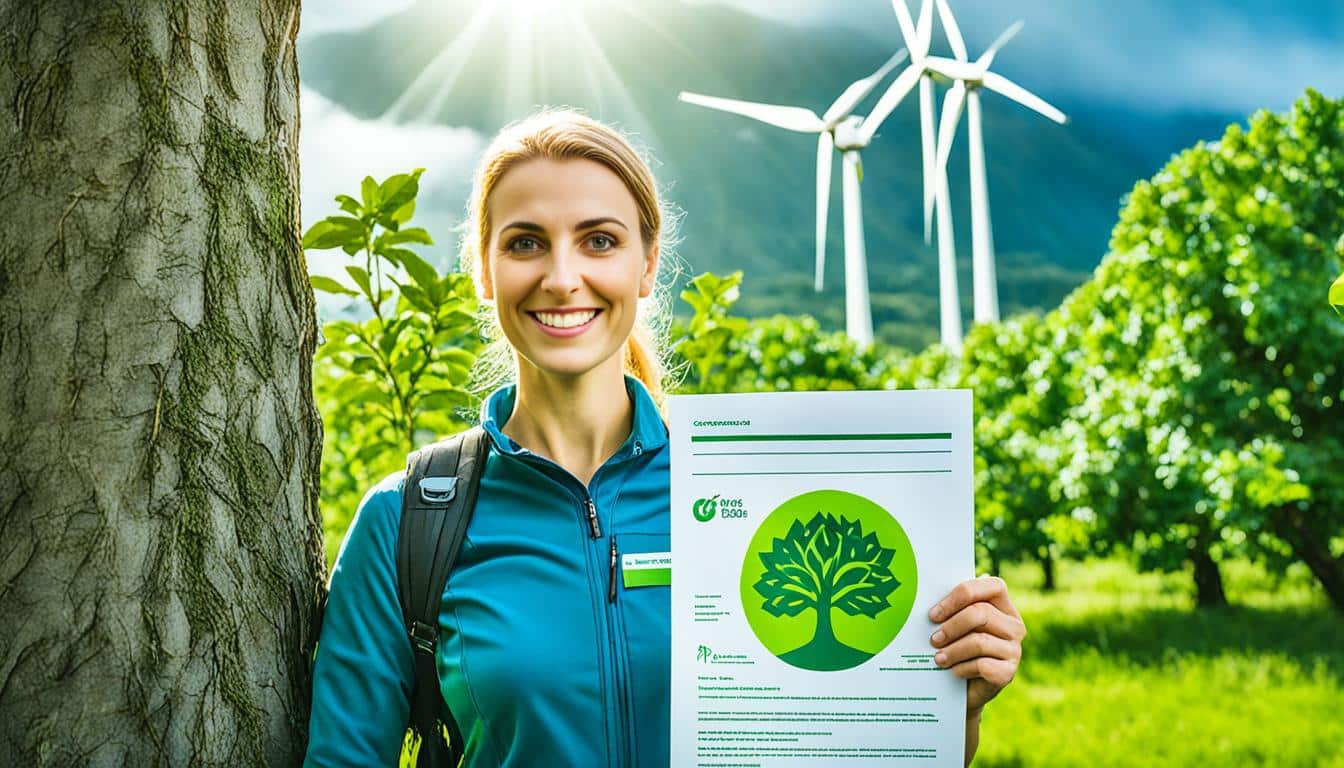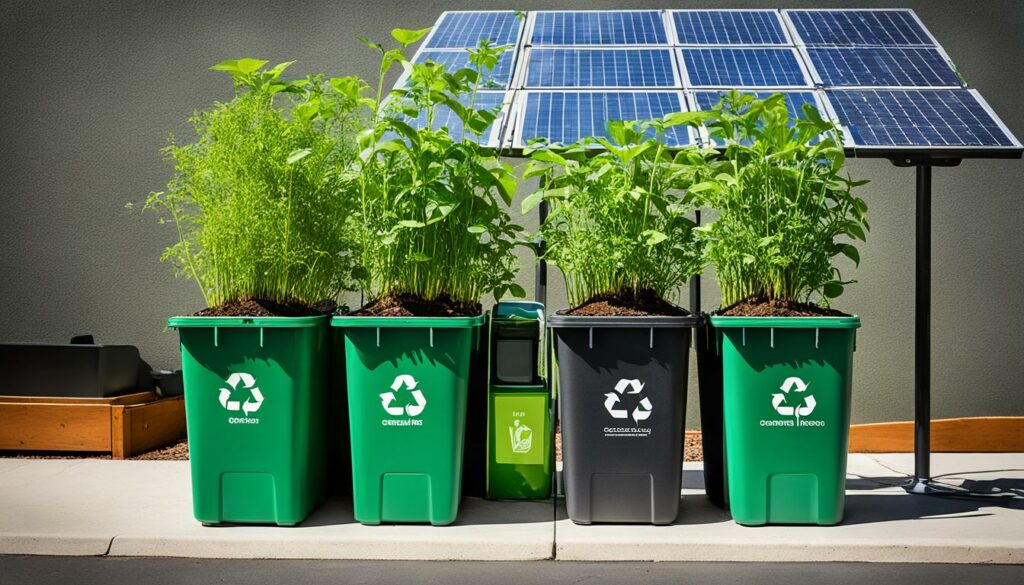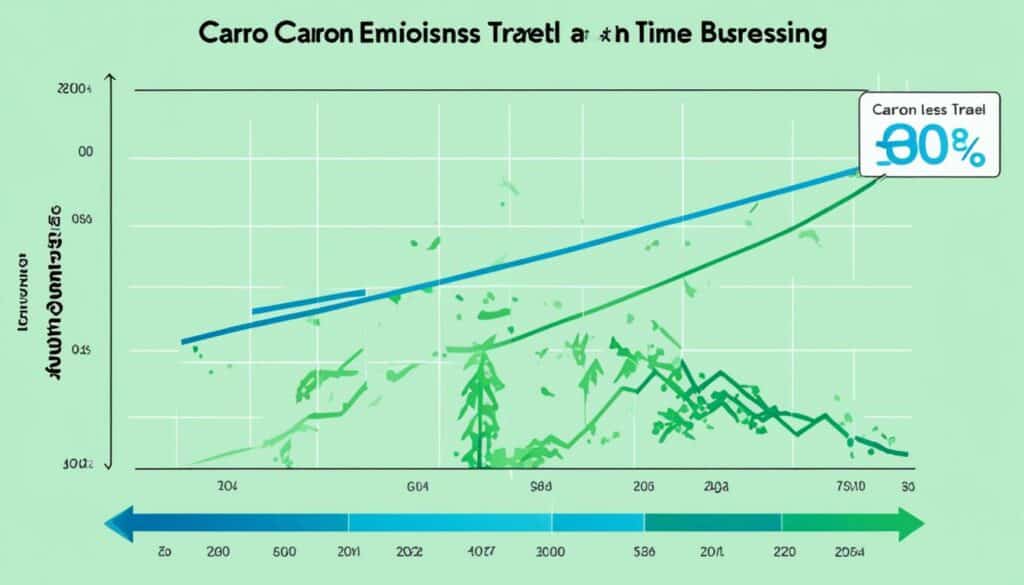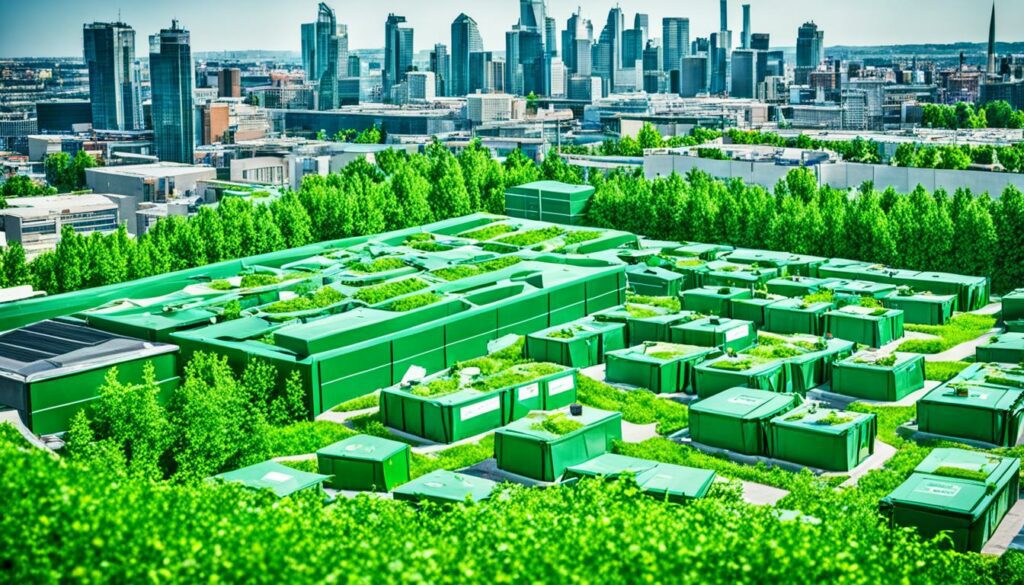Menu

Did you know that in 2020, transportation made up 27% of U.S. greenhouse gas emissions, says the United States Environmental Protection Agency? This big number shows why we must take serious actions to fight climate change.
I’m working hard to make our impact on the planet smaller. This means I look for ways to use less energy and produce fewer harmful emissions. By doing this, we help protect the earth for future generations.
My plan focuses on cutting down those harmful emissions. I aim to set targets to decrease our carbon footprint and then track our progress. Using new technology and changing how we do business, we hope to make a difference towards a greener future.
Realising the carbon footprint’s importance is key in fighting climate change. It shows all kinds of greenhouse gas emissions. These can come from everyday actions of individuals and businesses. They add to the problem of global warming. Learning about and reducing this footprint is a crucial first step towards a better future.
A typical U.S. home creates 48 t CO₂e yearly. Electrical use produced 578.3 Mt CO₂e in 2021. This was 9.1% of total emissions. Switching to LED lights saves over $200 yearly and cuts emissions greatly.
Cars and light trucks are a big source of emissions. In 2021, they produced 1.05 Gt CO₂e, making up 16.5%. The average car emits 0.77 pounds of CO₂ per mile. This shows we need greener travel options.
Our food choices also affect our carbon footprint. They might make up 10-30% of emissions. Eating local and wasting less can help our planet.
“Smaller houses use less energy, highlighting the importance of adjusting our living spaces to promote energy efficiency. Energy usage is significantly higher in single-family homes compared to other housing types.”
Businesses can make a big difference, too. Putting solar materials on 80% of a building’s roof can cut 125 Mt CO2e. Also, using aluminium on shipping containers would save $28 billion in fuel.
It’s clear we must change our ways quickly. By understanding and reducing greenhouse gas emissions, we can live more sustainably. This is essential for our planet’s future.
Here are some facts about where carbon emissions come from:
| Source | Emissions (Mt CO2e) | Percentage of Total Emissions |
|---|---|---|
| Residential Electricity Use | 578.3 | 9.1% |
| Cars and Light Trucks | 1,050 | 16.5% |
| Commercial Aircraft | 120 | N/A |
| Rail Transportation | 35.2 | 2% |
Understanding our carbon impact is essential. It encourages us all to work together against global warming. By taking responsibility for our actions, we can aim for a future that is both sustainable and secure.
To reach Net Zero carbon emissions, it’s key to set clear carbon cutting goals. My sustainability plan aims at setting targets that are easy to measure. They also meet the limits to global temperature rise as agreed in the Paris Agreement.
First, picking a Base Year is crucial. This sets a starting point for our carbon reduction efforts. By using Science Based Targets (SBTs), I align goals with the latest climate science. This makes sure our actions help keep global warming under 2°C.

Getting the right data is vital. It helps us spot where emissions come from and their effects. With this insight, I can buy carbon credits to offset any emissions left. This fits into my green strategy well. I learn from over 200 firms that use science-based goals. This keeps my plan strong and working.
My plan focuses on big, yet doable, goals. First, we cut emissions fitting with what climate science says. Then, we deal with any left by using carbon removal methods or buying credits. This approach not only makes steady progress. It also helps us aim for being carbon neutral by 2050. I work with organizations that use the SBTi approach. This helps me keep making a big difference by reducing a lot of emissions.
| Key Strategy | Details |
|---|---|
| Setting a Base Year | Establishing 2020 as the benchmark for measuring reductions |
| Science Based Targets | Aligning with Paris Agreement goals to limit warming to 1.5°C |
| Carbon Neutrality | Balancing emissions through carbon credits |
| Climate Positive Goals | Removing more emissions than released |
| Milestones | Yearly tracking and reporting to ensure targets are met |
Adding energy-saving steps to your daily habits is easy and effective. It can significantly cut down your household’s impact on the environment. This means lower energy bills for you.
Choosing appliances with an ENERGY STAR label is key. They work just as well but use less power. This move cuts your costs and helps the planet by cutting back on harmful gases.
The Energy Star programme has cut down on a massive 4 billion metric tons of carbon. It’s also saved families around $500 billion on energy bills. This proves that looking for the Energy Star tag is really worthwhile.
Programmable thermostats are a top energy-saving choice. They adjust temperature settings around when you’re home or away. Just changing the temperature a little can save big on energy.
This small adjustment can cut a lot from your bills. Smart thermostats give you fine control over your home’s climate. This way, you stay comfortable but with a lower energy footprint.
Devices left plugged in still use small amounts of power. It’s called vampire power because it sucks energy. Unplugging these when you’re not using them is a simple fix that can trim your bills.
Doing an energy check-up at home can point out where you’re losing power. It’s a good step to find more places where you can save. Each small change isn’t just good for your pocket. It helps the planet too, making your lifestyle cheaper and greener.
In 2020, 27% of the U.S. greenhouse gas emissions came from transportation. This makes controlling business travel crucial for big cuts in emissions. It’s not just about the environment; businesses need to think about the cost and efficiency of travel too.

Encouraging public transport can greatly reduce the carbon footprint of business travel. Trains, for example, produce much less CO2 than flights. Trainline’s research shows that trains are often quicker and cheaper, saving money and the planet.
Another great move is to use hybrid or electric cars for work trips. These vehicles cut down significantly on travel emissions. It helps meet a company’s green targets and lowers up to 90% of its travel-related carbon footprint.
Here’s a table comparing the environmental and financial impact of different travel choices:
| Travel Mode | CO2 Emissions (gCO2e/km) | Cost Efficiency | Speed |
|---|---|---|---|
| Trains | 35gCO2e/km | High | Moderate |
| Domestic Flights | 246gCO2e/km | Low | High |
| Electric Vehicles | 0gCO2e/km* | Moderate | Variable |
* Electricity used is assumed to come from renewable sources.
By smartly choosing travel policies, businesses can slash emissions and gain from green benefits. They can achieve this while ensuring their travel remains efficient and effective.
Finding suppliers who care about the planet is key to cutting our carbon footprint. It’s important for moving towards a greener supply chain. By working with suppliers who focus on ethical and carbon-reducing practices, we can make a big environmental difference.
We must look for sellers that share our green goals. Checking that their methods are in line with what we want helps a lot. Knowing every step of how our goods are made, moved, and kept helps find areas to cut carbon. Tools like the Greenhouse Gas Protocol help us figure this out.
Making sure our suppliers meet high eco-standards, like ISO 14001, is crucial. Such certifications prove they’re serious about protecting the environment. An example is how Salom Electronics, a Philips supplier, is making real green changes. They use certifications like ISO 14064 and ISO 14067 to cut their greenhouse gas emissions. Checking scores on how well vendors keep up with eco-goals is also important.
Carbon offsetting helps balance unavoidable emissions. Businesses buy carbon offset credits. This way, they can offset over 100 tonnes of CO2. It greatly helps climate protection efforts.
Carbon offsets are verified emissions reductions from specific projects. Companies like Carbon Footprint Ltd ensure these offsets meet high international standards. The Verified Carbon Standard (VCS) and the Gold Standard are important here. This check makes sure offset projects really make a difference. By offsetting, you reduce your ecological footprint. You also help with biodiversity, education, and food security in developing countries.
Buying renewable energy certificates is a powerful way to offset emissions. These certificates stand for a certain amount of clean energy. This clean energy lessens the need for fossil fuels. Projects cover many renewable sources. This includes solar and wind energy. They offer a green way for businesses to lower their carbon footprint.

Reforestation is key in carbon offsetting. It involves planting trees and restoring habitats. This process not only absorbs CO2 but helps in environmental recovery. It’s also vital for protecting biodiversity. Such efforts are crucial for a sustainable future worldwide.
The organisation is very strict about managing offsets. They are ISO 9001 certified. This means the authenticity and effect of each carbon offset is assured. Combining offsetting with cutting emissions is crucial. It’s the best way to move towards a low-carbon future.
| Year | Average Carbon Credit Price (USD/tonne) |
|---|---|
| 2019 | 4.33 |
| 2020 | 5.60 |
| 2021 | 4.73 |
| 2023 | 6.97 |
In conclusion, carbon offsetting is crucial in battling climate change. It helps businesses move towards a more sustainable tomorrow.
Starting a home energy audit is key to using less energy and making your home greener. Only 9% of homeowners have done a full check, even though it’s worth it. It costs around $400 and takes three to four hours. Yet, it can show you big ways to save energy and make your home friendlier to the planet.
The goal of an energy audit is to find places in your home that use too much energy. This can be due to old heating, bad insulation, or other issues. The inspector looks at insulation, heating, doors, windows, and more. They use tests like checking for drafts and using thermal cameras to see where energy is being lost.
After spotting the problems, the focus shifts to fixing them smartly. You can start with simple steps like stopping drafts, adding insulation, or buying better home appliances. Or, you might do bigger projects like getting new, energy-saving heating systems or improving how your windows keep in heat.
| Aspect | Details |
|---|---|
| Cost | Averages over $400, varies by location and audit type |
| Time | Typically 3-4 hours |
| Types of Audits | Preliminary and detailed |
| Tests Involved | Airtightness test, thermographic scan |
| Utility Bill Savings | Potential 5% to 30% reduction |
| Resale Value | Can increase with energy-efficient upgrades |
Concluding, an energy audit is a great start to saving energy and reducing waste at home. It gives you hints on how to efficiently improve your home. So, these checks are really worth it for making smart and big savings.
Enhancing waste management is key to sustainable living. Actions like cutting down on single-use items and recycling more help the earth. In the UK, many trusts stopped burning 900.8 tonnes of plastic in just a year. They also lessened cardboard recycling by 132.5 tonnes. They achieved this by using containers that could be reused.

The North West Anglia NHS Foundation Trust set a great example. They sent 87% less waste to be burned by changing how they managed trash. Also, Liverpool Women’s Hospital improved by making sure trash went in the right bins. Over half a year, they sent 40% less waste to be burned. Such acts show that managing waste wisely can hugely reduce trash and its harms.
Imagine how much waste we’d avoid if everyone used reusable containers from Sharpsmart. These containers can be washed up to 500 times. By using them, we’d cut down on waste and lessen CO2 emissions. So, tackling waste is not just about making less of it. It’s about helping our planet too.
When people travel, they create a lot of waste. The “URBANWASTE” project proves we can save between 4 and 189 kg of CO2 for every 1,000 tourists. This is by choosing responsible waste practices. By managing waste well, we do not just keep our surroundings clean. We also fight climate change and protect the earth’s resources.
By improving how we handle waste, we show we care about the planet. These actions are crucial in our fight for a healthier world. They are the foundation of our worldwide drive towards better waste management. This helps us live more in harmony with nature.
In today’s world, water is becoming scarce. It’s crucial that we all use water wisely. Doing so helps protect our planet and supports long-term plans for the earth.
Using low-flow fixtures is a key first step in saving water. These fixtures lower the amount of water used but keep your water flow strong. They’re great for homes and businesses alike.
Nevada’s goal to stop using ornamental turf by 2027 is a big push towards saving water. The low water levels at Lake Mead and Lake Powell, only at 26% full by April 2023, show we need to act fast.
It’s also vital not to waste water. Many water systems in the U.S. are old and lose a lot of water. Fixing leaks and choosing water-efficient appliances can help reduce this loss.
| State | Energy Use Reduction | Cost Savings |
|---|---|---|
| California | 19% electricity, 30% natural gas | $2.45 billion in electricity costs |
Studies at the University of California – Davis and LADWP show saving water can save money too. Also, it lowers the energy used, which helps fight against climate change. This is as good as taking 10 million cars off the road every year.
By combining these strategies, we can ensure water lasts. This will help us build a future that won’t run out of water.
Encouraging people to shop in eco-friendly ways is crucial. Mindful buying helps reduce our impact on the planet. This means picking items that are good for the environment. Retailers can help by offering more deals on sustainable products. This matches the wish of 56% of buyers wanting eco-friendly offers.

Telling the truth about how products are made is also important. Businesses like WeAreTala are leading the way in showing this. They make it so consumers understand the process behind their items. This builds trust and loyalty. Putting clear info about eco-friendly actions on tags helps consumers choose wisely.
Teaching through workshops and online materials like blogs and videos is powerful. This meets the needs of 33% who want help sticking to a budget while shopping green. Also, giving tips and facts helps build a community keen on saving our planet.
Being real about being green attracts eco-friendly partners and buyers. This makes a stronger market for green products.
Big names like IKEA and Patagonia are ahead in sustainable strategies. They serve as examples for the rest. Their green actions are good for the planet and for their image. By sharing their green achievements, retailers inspire us to shop smarter.
Keeping green claims simple and using QR codes to share detailed info is smart. This encourages careful shopping. When people work to be more eco-conscious, they join a global effort for a better world.
Choosing renewable energy sources is key to a better future. By moving to green options, we cut down on harmful emissions. This change reduces our use of fossil fuels, which cause most of the planet’s pollution.
One way to go green is to look at plans offered by local energy suppliers. These often use sources like wind, sun, and water to produce electricity. Using these plans can help lower our carbon footprint and make us more independent when it comes to energy.
Adding solar panels to your home or business is a great step. Over the last decade, the cost of solar power has dropped significantly. Now, it’s more affordable than ever and helps make our energy system more local. The goal is for most of our power to come from renewable sources by 2050.
Moving towards renewable energy isn’t just good for the environment. It can create millions of new jobs in sustainable tech by 2030. Plus, it will save us a lot of money by decreasing the harm caused by pollution.
So, whether through exploring green plans or putting up solar panels, choosing renewable energy matters. It’s a smart way to build a future that’s both eco-friendly and strong.
To fight climate change, getting every community involved is key. Together, we create a strong voice for the planet. This makes a big difference in spreading green actions.
Starting small, like sharing green tips with loved ones, is vital. Tips such as using less energy or handling recycling right can go a long way. Watching shows like “Our Planet” and “Before the Flood” can also help.
Plus, posts on social media can change minds and promote Earth-friendly habits. Everyone we inform joins in with our big community effort.
Getting involved with local green groups is a big step. Things like the People’s Climate March in D.C. in 2017 and global strikes show our united strength.
In 2022, the drive remains strong with strikes by Fridays for Future. By joining in, we support causes that benefit our world and its people.

Also, supporting groups working on policies is crucial for lasting change. This means contacting officials with clear and personal messages. In short, sharing tips and joining local actions set the path for a sustainable tomorrow.
Keeping an eye on our progress with carbon footprints is key. We use strong measures to see how well we’re doing. This helps us make smart moves based on facts.
Linking with other systems gives a complete look at our operations. It’s not just about the emissions we cause directly or from buying energy. It’s also looking at the whole chain of activities. This overall view is crucial for good reports and figuring out how we’re really doing.
Systems that can handle more data as we grow are a big help. It lets us keep up with our expanding work without a fuss. Using simpler platforms means we can change things fast to do better.
Having interfaces that are easy to use is a game-changer too. They get everyone involved, which means we get more accurate info. This is critical for setting the right goals and making our reports spot on.
Making sure suppliers are on board is vital. We need to get the right data from them. Working well with our suppliers helps us collect the right info and fix issues more effectively, making us better at what we do.
Joining up Supplier Relations, Data, Compliance, and Performance Management shows how important our connections are. The ESG trend makes accurate tracking and reports more crucial than ever.
Thinking big, global investments in sustainability have topped $35 trillion. This proves the world is serious about going green. It shows why keeping a close watch and aiming high is crucial.
| Aspect | Details | Impact |
|---|---|---|
| Data Model Flexibility | Quick insights & analysis | High agility in reports |
| System Integration | Holistic operational view | Enhanced decision-making |
| Scalability | Handles data growth | Continuous adaptability |
| Low Code Platforms | Quick system modifications | High flexibility |
| User Engagement | Greater participation | Accurate data entries |
Summarising the journey to reduce carbon footprints shows how important it is to use wide-ranging plans. Everything from what each person does to large company plans and community projects matter a lot. For example, in the UK, about 75% of the electricity used at work comes from sources that harm the environment. This fact makes shifting to clean, renewable energy very urgent.
When a company measures its carbon footprint, it looks at all its direct and indirect emissions. This includes the fuel used for heating and how employees get to work. Using a proper guide, like Defra’s emission factors, helps in accurately measuring these emissions. Taking steps to track, set goals, and lower emissions is key to effective management.
Investing in green technology can be very profitable, as shown by economic studies. As the world works harder to fight climate change, our role in taking care of the environment is more important than ever. By following through with these climate strategies, we ensure a better, sustainable tomorrow. It requires constant effort and the ability to deal with new challenges as they come up.
A carbon footprint policy is a plan to measure, manage, and cut greenhouse gas emissions. It applies to what we do daily and in business. The aim is to protect the environment and fight climate change.
It’s key to know how much our actions affect the environment. We measure this in CO2e units. Understanding our impact helps us make changes to be greener. This is vital for fighting climate change.
To reduce carbon, set clear goals, gather the right data, and make steps towards them. This method helps in aiming for zero carbon and in being eco-friendly.
Yes, aim to use energy more wisely. This includes getting energy-efficient items, using smart thermostats, and turning off gadgets when not needed. These actions can cut down on energy use and your carbon print.
Businesses can lessen travel emissions by driving less and using cleaner vehicles. They can also push for green travel choices. These steps protect the planet and maintain business efficiency.
Companies should pick suppliers who care for the environment. They should check if suppliers have important eco-friendly certifications. This helps in reducing total emissions linked to a company’s supply chain.
Carbon offsetting means making up for emissions by supporting eco-projects. These can be for clean energy or planting trees. It helps in balancing out your carbon usage.
An energy check-up at home finds where you waste energy. It shows how to use power better. This can cut your energy bills and help the planet.
Waste can be managed better with reducing, reusing, and recycling. Sorting waste properly cuts gases from landfills. It also supports recycling and a circular economy.
To save water, use devices that use less water and cut back on wastage. Doing this reduces your water use and helps protect resources.
Buying sustainable products and being mindful reduces environmental harm. It pushes companies to do better for the earth. This way, we all help protect the planet.
Using renewable power lessens fossil fuel use. It leads to a cleaner future, more energy security, and stronger ecosystems.
Teaching greener living, supporting local green projects, and pushing for eco-friendly laws matter. These actions spread awareness and bring benefits to nature and people.
Seeing how well we cut carbon is important for being honest and effective. It highlights where we’re doing well and where to improve. This is key for a lasting green future.